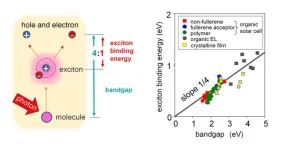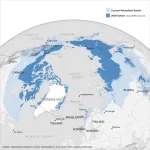(Press-News.org) New research has been published that identifies positive steps towards a better understanding of antimicrobial resistance (AMR), specifically in hospital-acquired pneumonia (HAP).
Antimicrobial, or antibiotic resistance, is a growing global issue, yet little is known about how to dose antibiotics to minimise bacteria developing resistance in patients. However, the University of Liverpool is playing a key role in contributing to international efforts to better understand AMR.
In a paper published today (Thursday 18 January), Dr Christopher Darlow, from the Antimicrobial Pharmacology & Therapeutics (APT) group at the University of Liverpool details a new experimental animal model of HAP. The model tests both the effect of meropenem – a commonly used antibiotic for HAP - and crucially determines how resistance to meropenem emerges.
Infections of the lungs are quite common in hospitals, with HAP accounting for approximately 10% of deaths in hospital. Because of the types of bacteria causing HAP and the large numbers of bacteria in the lungs during HAP, development of resistance to administered antibiotics to treat it is common. This is partly because doses of antibiotics are determined by drug developers to treat HAP effectively, but without consideration to the dose needed to prevent resistance emerging.
The team at the APT group, including Dr Darlow, have developed a new experimental model of HAP and used it to test the effects of meropenem. This model has allowed the team to detect both the amount of bacteria in the lungs as the antibiotic is given (i.e. is the antibiotic working to treat the infection) and also to detect the emergence of resistance, including by measuring the mutations in the genes of the bacteria that drive this.
In this work, the team demonstrated that too low doses of meropenem do treat HAP, but also cause a greater emergence of resistance. Conversely, resistance can be reduced by increasing the meropenem dose or by giving a second type of antibiotic (amikacin) at the same time. Both strategies may be used in clinical settings to reduce antimicrobial resistance. The team also mapped how the bacteria mutates and adapts to develop this resistance, giving insight into the underlying mechanisms.
Dr Christopher Darlow said: “Through this work we have highlighted the problem of resistance development in HAP when treated by meropenem and demonstrated potential strategies to prevent this i.e. increasing the meropenem or using a second antibiotic in combination. Beyond the implications for HAP, this is also a new experimental platform to allow antibiotics (both new and old) to be assessed for their ability to cause development of resistance and identify strategies to mitigate against this. We hope to use this platform for other antibiotics in the future to improve the use of antibiotics and prevent antibiotic resistance development.”
This pioneering research is being delivered through the Infection Innovation Consortium: iiCON, a global collaborative infectious disease R&D programme led by Liverpool School of Tropical Medicine, of which the University of Liverpool is a core partner.
The paper, ‘Molecular pharmacodynamics of meropenem for nosocomial pneumonia caused by Pseudomonas aeruginosa’ was published in mBio (DOI:10.1128/mbio.03165-23).
END
Tackling antibiotic resistance when treating pneumonia
New research by the University of Liverpool has been published that identifies positive steps towards a better understanding of antimicrobial resistance (AMR), specifically in hospital-acquired pneumonia (HAP)
2024-01-18
ELSE PRESS RELEASES FROM THIS DATE:
Stuck in traffic: Researchers identify cellular traffic jams in a rare disease
2024-01-18
Researchers from McGill University, led by Professor Alanna Watt of the Department of Biology, have identified previously unknown changes in brain cells affected by a neurological disease. Their research, published in eLife, could pave the way to future treatments for the disease.
Spinocerebellar ataxia type 6, known as SCA6, is a rare neurological disease that disrupts the function in a part of the brain called the cerebellum, causing difficulties with movement and coordination. The condition results from genetic mutations, ...
Study examines substance use in first responders during the COVID-19 pandemic
2024-01-18
Considerable attention has focused on burnout and mental health of physicians and nurses on the frontline during the COVID-19 pandemic. First responders – law enforcement personnel, firefighters and emergency medical service (EMS) providers, also experienced increased levels of stress, anxiety and depression due to job-related pressures associated with the pandemic.
Given their exposure to work-related stress during this time, first responders may have been at considerable risk of developing problematic substance use. However, little is known about the factors associated with first responder drug and alcohol use during the pandemic.
A study by Florida ...
Lighting the path: Exploring exciton binding energies in organic semiconductors
2024-01-18
Organic semiconductors are a class of materials that find applications in various electronic devices owing to their unique properties. One attribute that influences the optoelectronic property of these organic semiconductors is their "exciton binding energy," which is the energy needed to divide an exciton into its negative and positive constituents. Since high binding energies can have a significant impact on the functioning of optoelectronic devices, low binding energies are desirable. This can help in reducing energy losses in devices like organic solar cells. While several methods for designing organic materials with low binding energies have ...
Unlocking the secrets of quasicrystal magnetism: revealing a novel magnetic phase diagram
2024-01-18
Quasicrystals are intermetallic materials that have garnered significant attention from researchers aiming to advance condensed matter physics understanding. Unlike normal crystals, in which atoms are arranged in an ordered repeating pattern, quasicrystals have non-repeating ordered patterns of atoms. Their unique structure leads to many exotic and interesting properties, which are particularly useful for practical applications in spintronics and magnetic refrigeration.
A unique quasicrystal variant, known as the Tsai-type icosahedral quasicrystal (iQC) and their cubic approximant crystals (ACs), display intriguing characteristics. These include long-range ferromagnetic (FM) ...
DNA construction led to unexpected discovery of important cell function
2024-01-18
Researchers at Karolinska Institutet in Sweden have used DNA origami, the art of folding DNA into desired structures, to show how an important cell receptor can be activated in a previously unknown way. The result opens new avenues for understanding how the Notch signalling pathway works and how it is involved in several serious diseases. The study is published in Nature Communications.
Notch is a cell receptor that is of great importance to a wide range of organisms and plays a crucial role in many different processes, including early embryonic development in both flies and humans. Notch ...
Why animals shrink over time explained with new evolution theory
2024-01-18
The mystery behind why Alaskan horses, cryptodiran turtles and island lizards shrunk over time may have been solved in a new study.
The new theoretical research proposes that animal size over time depends on two key ecological factors: the intensity of direct competition for resources between species, and the risk of extinction from the environment.
Using computer models simulating evolution, the study, published today (Thursday, 18 January) in communications biology, identifies why some species gradually get smaller, as indicated by fossil records.
Dr Shovonlal Roy, an ecosystem modeller from the University of Reading who led the research, ...
CD19-targeted CAR NK cell therapy achieves promising one-year results in patients with B-cell malignancies
2024-01-18
Researchers from The University of Texas MD Anderson Cancer Center reported promising results in a Phase I/II trial of 37 patients with relapsed or refractory B-cell malignancies who were treated with cord blood-derived chimeric antigen receptor (CAR) natural killer (NK) cell therapy targeting CD19.
Published today in Nature Medicine, the findings reveal an overall response (OR) rate of 48.6% at 100 days post treatment, with one-year progression-free survival (PFS) and overall survival (OS) rates of 32% & 68%, respectively. The trial reported an excellent safety profile with no cases of severe cytokine release syndrome (CRS), neurotoxicity, ...
New cause of neuron death in Alzheimer's discovered
2024-01-18
· New finding to understand brain cell loss in neurodegenerative disease
· Increasing protective short RNAs may be new approach to halt or delay Alzheimer’s
· SuperAgers with superior memories have more protective short RNAs in their brains
CHICAGO --- Alzheimer’s disease, which is expected to have affected about 6.7 million patients in the U.S. in 2023, results in a substantial loss of brain cells. But the events that cause neuron death are poorly understood.
A new Northwestern Medicine study shows that RNA interference may play a key role in Alzheimer’s. For the first time, ...
Most Earth System Models are missing key piece of future climate puzzle
2024-01-18
The way science is funded is hampering Earth System Models and may be skewing important climate predictions, according to a new comment published in Nature Climate Change by Woodwell Climate Research Center and an international team of model experts.
Emissions from thawing permafrost, frozen ground in the North that contains twice as much carbon as the atmosphere does and is thawing due to human-caused climate warming, are one of the largest uncertainties in future climate projections. But accurate representation of permafrost dynamics is missing from ...
Shiyu discovery reveals East Asia’s advanced material culture by 45,000 years ago
2024-01-18
A team of researchers from China, Australia, France, Spain, and Germany has revealed advanced material culture in East Asia by 45,000 years ago.
The new study was published in Nature Ecology & Evolution on Jan. 18.
The researchers examined a previously excavated archaeological collection from the Shiyu site, located in Shanxi Province.
"Our new study identified an Initial Upper Palaeolithic archaeological assemblage from the Shiyu site of North China dating to 45,000 years ago that includes blade technology, tanged and hafted projectile points, long-distance obsidian transfer, and the use of a perforated ...
LAST 30 PRESS RELEASES:
Interaction of climate change and human activity and its impact on plant diversity in Qinghai-Tibet plateau
From addressing uncertainty to national strategy: an interpretation of Professor Lim Siong Guan’s views
Clinical trials on AI language model use in digestive healthcare
Scientists improve robotic visual–inertial trajectory localization accuracy using cross-modal interaction and selection techniques
Correlation between cancer cachexia and immune-related adverse events in HCC
Human adipose tissue: a new source for functional organoids
Metro lines double as freight highways during off-peak hours, Beijing study shows
Biomedical functions and applications of nanomaterials in tumor diagnosis and treatment: perspectives from ophthalmic oncology
3D imaging unveils how passivation improves perovskite solar cell performance
Enriching framework Al sites in 8-membered rings of Cu-SSZ-39 zeolite to enhance low-temperature ammonia selective catalytic reduction performance
AI-powered RNA drug development: a new frontier in therapeutics
Decoupling the HOR enhancement on PtRu: Dynamically matching interfacial water to reaction coordinates
Sulfur isn’t poisonous when it synergistically acts with phosphine in olefins hydroformylation
URI researchers uncover molecular mechanisms behind speciation in corals
Chitin based carbon aerogel offers a cleaner way to store thermal energy
Tracing hidden sources of nitrate pollution in rapidly changing rural urban landscapes
Viruses on plastic pollution may quietly accelerate the spread of antibiotic resistance
Three UH Rainbow Babies & Children’s faculty elected to prestigious American Pediatric Society
Tunnel resilience models unveiled to aid post-earthquake recovery
Satellite communication systems: the future of 5G/6G connectivity
Space computing power networks: a new frontier for satellite technologies
Experiments advance potential of protein that makes hydrogen sulfide as a therapeutic target for Alzheimer’s disease
Examining private equity’s role in fertility care
Current Molecular Pharmacology achieves a landmark: real-time CiteScore advances to 7.2
Skeletal muscle epigenetic clocks developed using postmortem tissue from an Asian population
Estimating unemployment rates with social media data
Climate policies can backfire by eroding “green” values, study finds
Too much screen time too soon? A*STAR study links infant screen exposure to brain changes and teen anxiety
Global psychiatry mourns Professor Dan Stein, visionary who transformed mental health science across Africa and beyond
KIST develops eco-friendly palladium recovery technology to safeguard resource security
[Press-News.org] Tackling antibiotic resistance when treating pneumoniaNew research by the University of Liverpool has been published that identifies positive steps towards a better understanding of antimicrobial resistance (AMR), specifically in hospital-acquired pneumonia (HAP)




